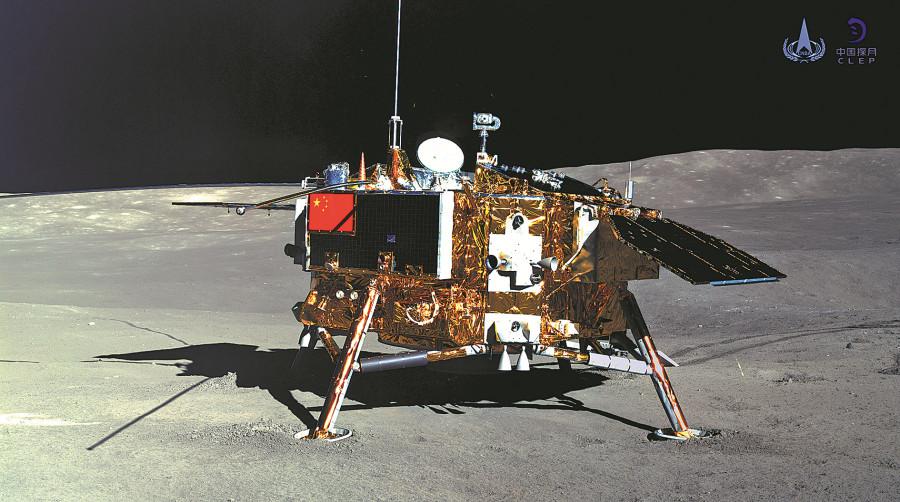


Photo taken by the rover Yutu 2 (Jade Rabbit-2) on Jan 11, 2019 shows the lander of the Chang'e 4 probe. [Photo/Xinhua/China National Space Administration]
XIAMEN -- China plans to launch the Chang'e-5 probe in 2020 to bring moon samples back to Earth, according to Wu Weiren, chief designer of China's lunar exploration program.
The Long March-5 carrier rocket, China's current largest launch vehicle, will be used to send the probe into space, Wu, also an academician of the Chinese Academy of Engineering, said at the first China Space Science Assembly, which opened Saturday in Xiamen, East China's Fujian province.
The second Long March-5 rocket was launched from the Wenchang Space Launch Center in the southern province of Hainan on July 2, 2017, but a malfunction happened less than six minutes after its liftoff.
China's space engineers have spent over two years looking for the cause of the malfunction. The third Long March-5 rocket is being transported to the Wenchang Space Launch Center for a new flight, according to Wu.
The success of the flight will be the key for China's future space missions including the Chang'e-5 probe.
Wu said the Chang'e-5 probe includes a lander, an orbiter, an ascender and a returner. The key of the mission will be lunar sample collection, takeoff from the moon, rendezvous and docking on lunar orbit and high-speed reentry into Earth' atmosphere.
China's current lunar program includes three phases: orbiting, landing, and returning. The first two phases have been accomplished, and the next step is to launch the Chang'e-5 probe to collect 2 kg of moon samples and bring them back to the earth.
China is also drawing up the plan for the fourth phase of the lunar exploration program.
In the fourth phase of the program, China will conduct scientific detection in the south polar region of the moon by mainly using high intelligent robots, and realize long-term exploration in the complicated lunar environment, Wu said.
There might be some ancient craters and frozen water at the south pole of the moon, which is of great research value, said Wu.
 Fire brigade in Shanghai holds group wedding
Fire brigade in Shanghai holds group wedding Tourists enjoy ice sculptures in Datan Town, north China
Tourists enjoy ice sculptures in Datan Town, north China Sunset scenery of Dayan Pagoda in Xi'an
Sunset scenery of Dayan Pagoda in Xi'an Tourists have fun at scenic spot in Nanlong Town, NW China
Tourists have fun at scenic spot in Nanlong Town, NW China Harbin attracts tourists by making best use of ice in winter
Harbin attracts tourists by making best use of ice in winter In pics: FIS Alpine Ski Women's World Cup Slalom
In pics: FIS Alpine Ski Women's World Cup Slalom Black-necked cranes rest at reservoir in Lhunzhub County, Lhasa
Black-necked cranes rest at reservoir in Lhunzhub County, Lhasa China's FAST telescope will be available to foreign scientists in April
China's FAST telescope will be available to foreign scientists in April "She power" plays indispensable role in poverty alleviation
"She power" plays indispensable role in poverty alleviation Top 10 world news events of People's Daily in 2020
Top 10 world news events of People's Daily in 2020 Top 10 China news events of People's Daily in 2020
Top 10 China news events of People's Daily in 2020 Top 10 media buzzwords of 2020
Top 10 media buzzwords of 2020 Year-ender:10 major tourism stories of 2020
Year-ender:10 major tourism stories of 2020 No interference in Venezuelan issues
No interference in Venezuelan issues
 Biz prepares for trade spat
Biz prepares for trade spat
 Broadcasting Continent
Broadcasting Continent Australia wins Chinese CEOs as US loses
Australia wins Chinese CEOs as US loses